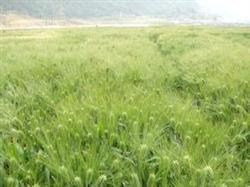How to prevent the rotten seeds of spring peanuts after sowing

Rotten seeds often occur before emergence of spring peanuts after sowing, and the serious rate of rotten seeds is as high as 20%, resulting in varying degrees of lack of seedlings and broken ridges. Causes of rotten seeds: poor seed quality or improper storage, long storage period; low-lying terrain, heavy soil viscosity, poor texture, high soil water content, long seedling emergence time; unsolid soil preparation, affecting seed water absorption, weak seedlings; seeds are not selected, uneven size, sowing is not fine or different depth, resulting in uneven emergence or lack of seedling broken ridges; continuous cropping for many years, serious diseases in seedling stage, resulting in lack of seedlings and broken ridges The application of undermature organic fertilizer or too high fertilization concentration will cause fertilizer damage and affect seedling emergence; low temperature for a long time, resulting in slow germination and rotten seeds. Prevention and control methods: (1) fine seed selection. Select new peanut seeds, harvest the remaining peanuts in time and dry them in time, so as to store them scientifically. Drying seeds with skin before sowing can speed up peanut metabolism, enhance seed penetration and improve seed water absorption. 1-3 days before sowing, the seeds without damage and radicle germination were selected and sown. (2) seed dressing with chemicals. Seed dressing with 50% methyl carbendazim or 50% carbendazim wettable powder of 0.1% seed weight to prevent seedling diseases. It can also be mixed with 50% phoxim EC of 0.2% seed weight to control underground pests and bird and rodent pests. (3) fine sowing. Sow at a depth of 4cm to 6cm and avoid contact with fertilizer. By using plastic film mulching cultivation, the ground temperature can be increased by 2 ℃ ~ 3 ℃. After sowing, seeds germinate and seedlings emerge quickly, and the disease can be reduced.
- Prev

Technology of plastic Film mulching in large area of Spring Peanut to increase yield by soil moisture and dry sowing
Plastic film mulching for fruit sowing is an effective measure to protect the whole seedling, resist drought and increase yield of spring peanut by early sowing. Linmu County Agricultural Technology extension Center began to experiment and demonstrate in 1987. From 1992 to 1993, the implementation area reached 8520 hectares, with an average yield of 3982.5 kg / ha and 4057.5 kg / ha, an increase of 13.9% and 16%.
- Next

Weeding in barley field
The coastal areas of our province are mainly rice-wheat rotation. Due to the need of crop regulation, it is necessary to plant a certain area of malting barley every year. On the basis of optimizing the distribution of varieties, standardized cultivation measures can improve the quality indexes such as grain shape uniformity, 1000-grain weight and grain protein content of malting barley.
Related
- The first cup of black tea in spring, the flavor and history of tea gardens in Kenya, Africa
- The computer can not only choose potatoes, but also grow tea rice. AI will grow winter oolong tea champion.
- It is not only the inflated tea bitten by insects, but also engraved with the four seasons tea in Beipu.
- The Oriental Beauty Tea Festival in Zhuxian County takes the stage at the weekend to experience the plus-size feast of oil tea.
- & quot; Oriental Beauty Tea & Exploration of Emei in Hsinchu, the hometown of quot;
- The new variety of strawberry "Tainong 1" dessert is the first choice with mellow aroma. Crimson gorgeous
- History of Tea in Taiwan: from Wild Inner Mountain to Export Tea Garden
- Two types of Taiwan Oriental Beauty Black Tea won the British three-Star Award for Childhood Tea Xiang Zhang Jiaqi changed from pilot to champion tea maker.
- Banana species and varieties: the planting history of Taiwan Xianren banana and dwarf banana is long, is banana disease resistant?
- Coffee planting Technology: Qianjie Coffee from Seedling to harvesting

